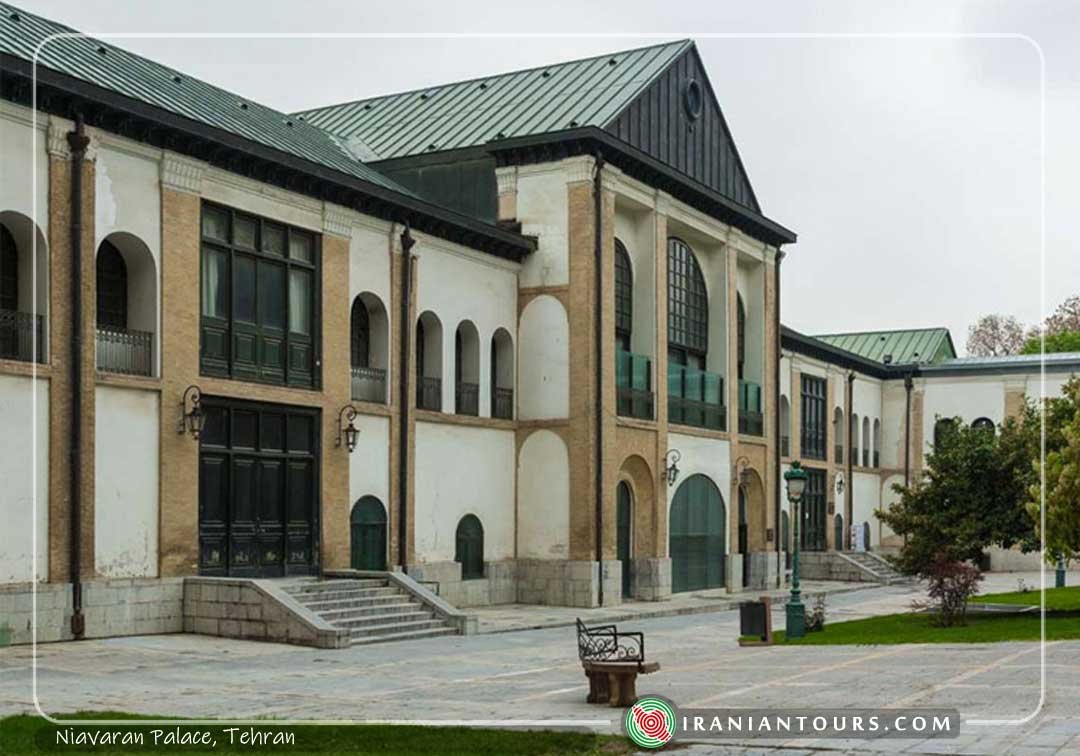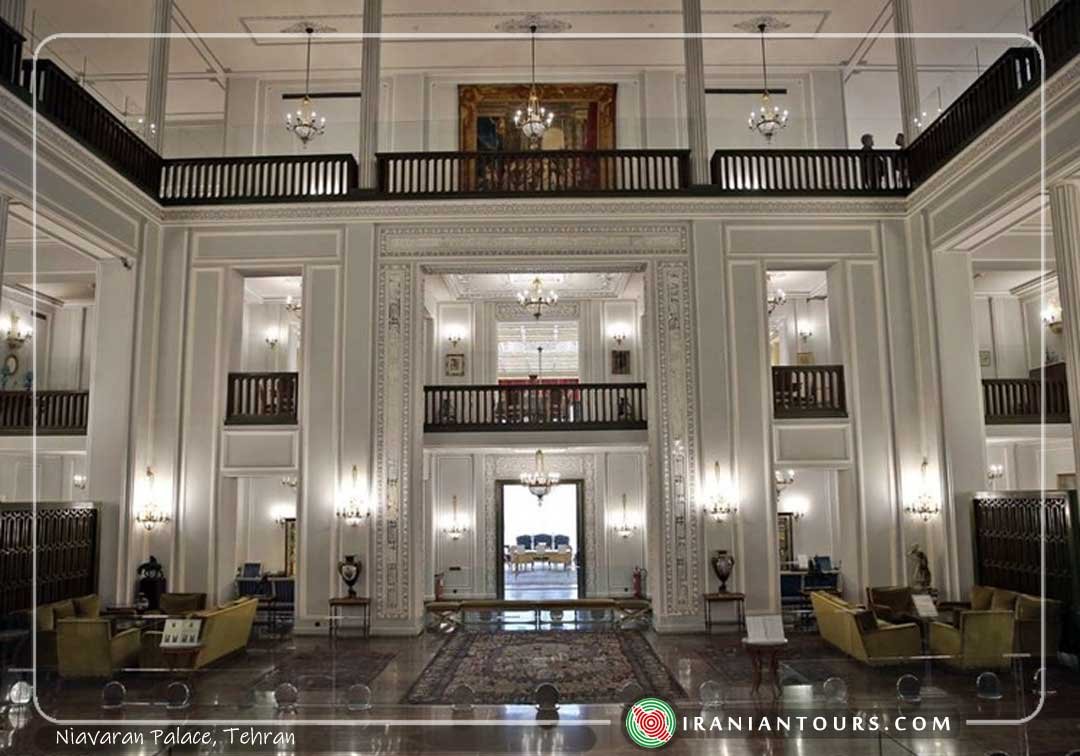Niavaran Palace
The Niavaran Palace Complex (Persian: Kakh-e Niāvarān) is a historical palace complex situated in Shemiran (northern Tehran), Iran. It consists of several palace buildings and monuments dating back to the Qajar and Pahlavi eras.
The complex traces its origin to a garden in the region of Niavaran, which was used as a summer residence by Fath-Ali Shah (1772-1834) of the Qajar Dynasty.
A pavilion was built in the garden by the order of Naser-ed-Din Shah (1831-1896) of the same dynasty, which was initially referred to as Niavaran, and was later renamed Saheb-Qaranie. The pavilion of Ahmad Shah Qajar (1898-1930) was built in the late Qajar period.
During the reign of the Pahlavi Dynasty, a new palace named Niavaran was built for the imperial family of Mohammad Reza Shah (1919-1980). All of the peripheral buildings of the Saheb Qaranie, with the exception of the Ahmad Shahi Pavilion, were demolished, and the present-day structures were built to the north of the Saheb-Qaranie. The Ahmad Shahi Pavilion was then used as an exhibition centre for presents from world leaders to the Iranian imperial monarchs.
Saheb Qaranieh
This pavilion was built by the order of Naser-al-din Shah Qajar, in an area much higher than its surrounding fields and the city. A smaller building existed in place of the current palace; it was demolished on the king’s command and a new building, Saheb Qaranieh, Naser-al-din Shah’s favorite summer residence, replaced it.
After the Qajarid era, Saheb Qaranieh was forgotten until 1940 when the palace was restored to host Mohammad Reza Pahlavi’s wedding with Fawzieh. Later, this palace functioned as the working office of Mohammad Reza Shah and his wife. After the Islamic revolution, some other restorations were done to change it into a museum. This building is divided into a Private (andaruni) and a Public (biruni) part. It consists of a howz-khaneh (pool house) in the basement, and the Jahan Nama Hall on the upper floor. The howz-khaneh includes several rooms whose ceilings are covered with painted logs brought from monuments of Shiraz in the Pahlavi era. This hall is the second most exquisite hall of the palace in terms of decorations and stucco work. The iconic rooms in the basement are Naser-al-din shah’s cloakroom with a 12th-century wooden ceiling, Korsi Khaneh, (a room housing a traditional table with a heater underneath it) on the northeastern side, and a bathroom at the western end. The delicate stucco work and inscriptions in this room make it one of the most spectacular rooms in this palace.
Jahan Nama Hall is a cross-shaped area located on the upper floor. It literally means overlooking the world, named so because of giving a panoramic view of the city. The collection on display here includes objects from pre-historic times to the contemporary years of Iran and the world. The iconic works by Warhol, Picasso, and Joan Miró share space with Iranian archaeological artifacts. There are four rooms at the corners, two rooms are filled with small but well-displayed examples of the modern and ancient artworks gathered by Farah Diba, mainly during the 1970s.
Niavaran Palace
The next and the most important building in the complex is located in the northeast corner of Niavaran garden. This structure which bears the name of the garden, Niavaran, is about 9000 square meters and is composed of two and a half stores. The decoration is inspired by Islamic and pre-Islamic elements such as mirror work, stucco, and tilework. The floor is covered with black granite and the ceiling is made of Aluminum. This roof is movable and used to be opened for the crown prince, Reza Pahlavi, to observe the stars in the shiny sky of Niavaran. First, it was planned to be a place for royal parties to host the senior royal guests but, during the construction, it turned into the house of the Pahlavi family. Then in 1958, Mohammad Reza Shah, with his queen, Farah Diba, left Saad-Abad palace to live in Niavaran. You can observe the Iranian architecture and the special lifestyle in Iran dating back to 50 years ago. The ground floor includes a private building, a dining room, a reception hall, a waiting room, and corridors.
Farah’s hairdressing room, the princess’ and prince’s rooms, their governess’ room, and the conference room are all located on the upper floors. These rooms and their furniture were repaired over six years, from 2004 to 2010. Everything seems so intact and normal as if the royal life is still going on here!
Royal Library
The Royal Library is a two-storied building, flanking the Niavaran Palace. The wise combination of glasses and mirrors shows an acute taste of inner decoration, carried out by Aziz Farman Farmayan and Charles Serigny, an American artist. This library contains more than 23000 books which mostly includes the history of Iran, French literature, and paintings. The printed books are worthy to be visited even if it is for their royal binding. The oldest non-Persian book in the library is written by Josephus Flavius in the 17th century. The highlights are a Cinderella book, a gift from Walt Disney with his signature to the crown prince of Iran, and a book by Hans Christian Anderson translated and illustrated by the former queen of Iran, Farah Diba. Other items such as a large piano, the furniture and some statues and paintings by Iranian and international artists are also on display here.
Ahmad Shahi Pavilion
The Ahmad Shāhī pavilion is a two-story building built at the end of the Qajarid era as the summer residence of Ahmad Shah. This edifice is the second oldest building after Saheb Qaranieh. The iconic feature of this building is its fine molded brickwork on the façade. In terms of brick decorations, there are two other similar edifices in Tehran: Ceramic Museum and Teimurtash house. The main entrance is on the southwest leading into the building with a series of steps. The ground floor consists of a vestibule, with a marble pool at the center, six rooms, and two corridors. The second floor comprises a central hall, which used to be a music room, and four porticoes holding 26 circular columns and six square columns.
This pavilion was renovated during the reign of Mohammad Reza Shah Pahlavi and turned into the house and workplace of Reza Pahlavi, the former crown prince of Iran. What is left of Reza Pahlavi in this pavilion, from his portrait on the wall to his school records and his excellent music instrument collection shows that he didn’t have any idea for permanent immigration to any foreign country. After the Islamic revolution, this building went under several phases of restorations.
Royal Car Museum
The royal car museum is the last visiting place before leaving Niavaran complex. In a space of 200 square meters, formerly used as the garage of the palace, you can have a look at royal cars belonging to the family of Mohammad Reza Pahlavi, a number of small motorcycles belonging to his children, and the replicas of royal cars kept in this museum.
The Garden of Reliefs
There are 43 replicas of Iranian reliefs on display on the eastern wing of the garden. Among the reliefs, from Assyrians and Medes to Parthians and Sassanids eras, Shapour and Ardeshir inscriptions in Naqsh-e-Rostam and Shapour I relief in Naqsh-e-Rajab are worthy of special attention.




